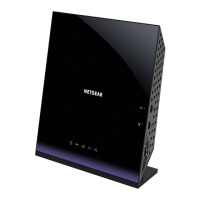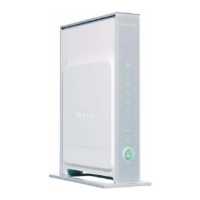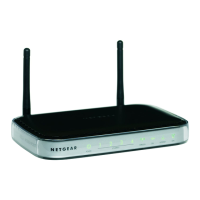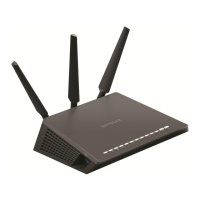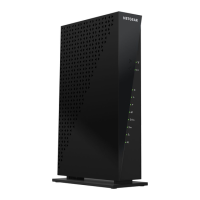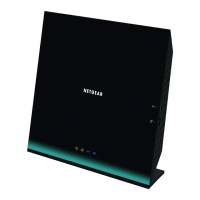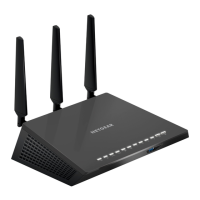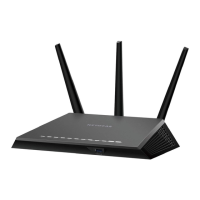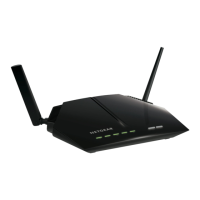
Do you have a question about the NETGEAR D6220 and is the answer not in the manual?
| Brand | NETGEAR |
|---|---|
| Model | D6220 |
| Category | Network Router |
| Language | English |
Instructions for unpacking the modem router and its accessories.
Description of the LEDs and buttons on the modem router's top panel.
Details of the ports, buttons, and power connector on the back panel.
Information found on the product label on the bottom panel of the modem router.
Guidelines for optimal placement of the modem router for best WiFi signal.
Instructions for connecting to the modem router via wired or WiFi.
Steps to configure the modem router for DSL internet service.
Steps to configure the modem router for cable internet service.
How to log in to the modem router's web interface to change settings.
Using the setup wizard to configure internet settings after initial setup.
Manual configuration steps for ADSL internet connections.
Manual configuration steps for VDSL internet connections.
Manual configuration steps for cable internet connections.
Specifying settings for various IPv6 internet connection types.
Configuring SSID, security, and other basic settings for the main WiFi network.
Connecting WiFi devices using Wi-Fi Protected Setup (WPS) button or PIN.
Setting up and securing a separate WiFi network for guests.
Enabling or disabling the WiFi radios on the modem router.
Configuring parental controls to filter web content for devices on the network.
Using MAC addresses to allow or block specific devices from network access.
Blocking specific keywords or domains to prevent access to certain websites.
Creating rules to control outbound traffic for services and applications.
Using Quality of Service (QoS) to prioritize internet traffic for specific applications.
Creating and managing QoS rules for applications, games, or devices.
Configuring WMM QoS to prioritize wireless voice and video traffic.
Enhancing WiFi range and performance using beamforming technology.
Enabling Universal Plug and Play (UPnP) for easier device network discovery.
Specifications and compatibility requirements for USB storage devices.
Steps to physically connect a USB storage device to the modem router.
Accessing files on a USB device from Windows or Mac computers.
Mapping a USB device as a network drive in Windows for easier access.
Enabling FTP access to share files on USB devices within the local network.
Procedures for safely disconnecting a USB device from the modem router.
Setting up Dynamic DNS to access the network using a domain name.
Accessing USB storage devices remotely via the Internet.
Using FTP to download or upload files from USB devices remotely.
Configuring the modem router to function as a DLNA media server.
Playing media files stored on a USB device using a TiVo device.
Configuring the modem router to be compatible with TiVo media playback.
Installing printer drivers and physically connecting the USB printer.
Downloading the ReadySHARE Printer utility for various devices.
Using the shared USB printer from connected computers on the network.
Configuring settings for the NETGEAR USB Control Center utility.
Selecting between DSL or Ethernet WAN port for internet connection.
Setting up Virtual LANs (VLANs) for network segmentation and IPTV traffic.
Configuring WAN security features like port scan and DoS protection.
Changing the modem router's LAN IP address and subnet mask.
Assigning static IP addresses to devices on the LAN via DHCP reservation.
Disabling the modem router's DHCP server to use an external DHCP server.
Checking for and installing new firmware to update the modem router.
Changing the default administrator password for enhanced security.
Resetting the modem router to its original factory default settings.
Viewing information about the modem router's status and network statistics.
Viewing, emailing, and clearing the router's activity and security logs.
Monitoring and controlling internet traffic volume and connection time.
Scheduling when WiFi signals are turned on or off for each WiFi band.
Configuring default settings for Wi-Fi Protected Setup (WPS) connections.
Adjusting advanced WiFi settings like coexistence and fragmentation length.
Setting up the modem router to function exclusively as a WiFi access point.
Setting up the modem router to enable VPN connections for remote access.
Installing the OpenVPN client software on a Windows computer.
Installing the OpenVPN client software on a Mac computer.
Establishing a VPN tunnel from a Windows computer to the modem router.
Accessing your home internet service remotely using a VPN connection.
Setting up rules to forward incoming traffic to specific local servers or applications.
Creating a port forwarding rule for a custom service or application.
Modifying existing port forwarding rules.
Deleting existing port forwarding rules.
Defining custom rules for port triggering to open inbound ports dynamically.
Temporarily disabling port triggering without removing existing rules.
Provides quick steps to resolve common network and modem router issues.
Interpreting modem router LEDs to diagnose connection and status problems.
Steps to resolve issues preventing login to the modem router's web interface.
Diagnosing and resolving problems with the modem router's internet connection.
Steps to diagnose and fix issues with WiFi connectivity to the modem router.
Using the ping utility to test network connectivity and diagnose issues.
Details of the modem router's default factory settings.
Specifications related to the modem router's hardware and capabilities.
